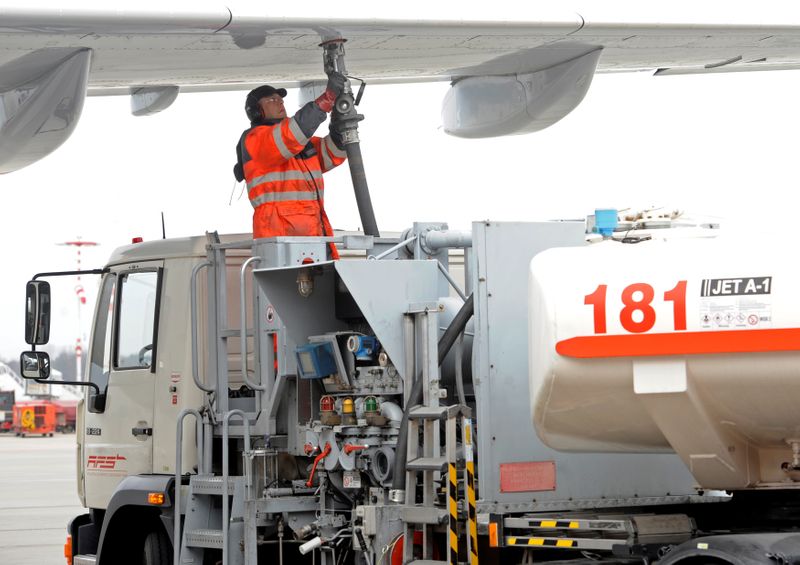By Bozorgmehr Sharafedin, Koustav Samanta and Stephanie Kelly
LONDON/SINGAPORE/NEW YORK (Reuters) - Hopes of a speedy aviation recovery this year have been knocked back by global travel restrictions after the emergence of new coronavirus variants and a slower than expected vaccination rollout, dimming the outlook for jet fuel demand and oil prices.
Jet fuel suffered the biggest demand decline among oil products as aviation activity collapsed last year and is seen by market participants as one of the main factors influencing 2021 oil demand growth, given the lingering uncertainties.
Almost 10% of total oil demand in OECD countries was for jet fuel in 2019, dropping to 6% in 2020, International Energy Agency (IEA) data shows. By comparison, gasoline demand remained around 30% in both 2019 and 2020.
Goldman Sachs (NYSE:GS) last month lowered its forecast for first-quarter global oil demand by 700,000 barrels per day (bpd), or 0.7% of total consumption, mainly because of renewed travel restrictions.
EMPTY SKIES
Analysts and traders had expected a swift recovery for jet fuel consumption on the back of a bounce in leisure travel. However, vaccination programmes have been delayed and the skies remain empty, with thousands of planes grounded by the pandemic and many airlines pushed to the verge of bankruptcy.
"For the short-term, there is still no sign of recovery for jet fuel," said a senior jet fuel trader associated with a Japanese refiner.
Most traders and analysts now expect the situation to improve only in the second half of the year as vaccine rollouts continue and domestic flights pick up. A recovery in international flights, however, is expected to take longer.
Long-haul flights burn an average of about 35 times more fuel than regional flights, the IEA says, and are responsible for more than a third of total fuel used by the aviation sector.
Jet fuel demand will remain at about 5.4 and 5.7 million bpd in the first and second quarters respectively, research consultancy Energy Aspects projects, far below average global consumption of 7.9 million bpd in 2019.
MARGINS AND INVENTORIES
In Asia, jet fuel cracks, or margins, have gained in recent weeks but remain at record lows for the time of year.
"Refiners with substantial domestic markets will try to run just enough to produce jet fuel to meet domestic demand as the international market is still weak," one senior jet fuel trader said.
In Europe, jet fuel cracks continue to rise, mainly owing to expected heavy refinery maintenance work rather than strong demand.
Jet fuel held in independent storage in the Amsterdam-Rotterdam-Antwerp (ARA) hub rose in the week to Thursday to 983,000 tonnes, almost 110% higher than the same period last year.
Global jet fuel floating storage, meanwhile, rose to about 4 million barrels in early February, having dropped from a peak of about 20 million barrels in August 2020 to almost 2.5 million barrels last month, according to data intelligence firm Kpler.
Graphic: Jet fuel floating storage https://graphics.reuters.com/GLOBAL-OIL/xklpylwjevg/chart.png
The emergence of more contagious variants of the virus has severely affected intercontinental travel, with recovery expected to be arduous, which analysts and traders say could be most painful for Middle East refiners that are heavily reliant on such flights.
With new refining capacity coming online in the region this year, the refiners have no option but to export more jet fuel to already oversupplied markets.
In the United States, airline passenger volumes are still down 65% from pre-pandemic levels, said U.S. industry group Airlines for America.
American Airlines (NASDAQ:AAL) said in its fourth-quarter report that it is looking at 2021 as "a year of recovery" but could not predict exactly when passenger demand will return.
SECOND-HALF UPTURN?
Analysts at Wood Mackenzie have their sights set on the back end of 2021 for the jet fuel recovery to kick in.
"We expect to see the critical mass vaccinated by the end of the third quarter and beginning of the fourth quarter, and that’s when you will see the pace of jet fuel demand pick up," said Suzanne Danforth, Wood Mackenzie’s Americas markets lead for the oils and refining markets.
U.S. refiners raised their jet fuel yields - the percentage of finished product from input of crude oil - towards the end of 2020 and are expected to increase them throughout the year, Danforth said.
Pre-pandemic yields of about 10.5% fell to 6.8% last year, she added.
But there's no getting away from the uncertainty that clouds the market. U.S. Energy Information Administration data showed that U.S. jet fuel demand hit nearly 1.5 million bpd in the week to Jan. 8, its highest since March last year, only to drop back to 1.3 million bpd in the week to Feb. 5.
Graphic: Cloudy skies ahead for jet fuel demand as travel restrictions tighten https://fingfx.thomsonreuters.com/gfx/ce/jznpnmyzwvl/FlightRecoveryFeb2021.png
